Small overlap front
The small overlap front evaluation consists of a driver-side and a passenger-side component. This vehicle has an incomplete rating because it has been tested only on one side.
Driver-side
- Rating applies to 2017-24 models
Tested vehicle: 2014 Mitsubishi Mirage DE 4-door
The Mitsubishi Mirage hatchback was introduced in the 2014 model year, and the 2016 model year was skipped. The Mirage G4 sedan was introduced in the 2017 model year. Beginning with 2017 models of both the hatchback and sedan, the side curtain airbags were lengthened to improve occupant protection in small overlap frontal crashes.
Assessment of side airbag coverage is determined by the Institute based on a test of a 2017 model Mirage conducted by Mitsubishi. All other assessments, ratings, and vehicle specifications are based on the original Institute test of a 2014 model Mirage.
The small overlap frontal crash test ratings on this page apply to both the Mirage hatchback and Mirage G4 sedan beginning with 2017 models.
| Evaluation criteria | Rating |
|---|---|
| Overall driver-side evaluation | |
| Structure and safety cage | |
| Driver injury measures | |
| Head/neck | |
| Chest | |
| Hip/thigh | |
| Lower leg/foot | |
|
Driver restraints and dummy kinematics
In the Institute's test of the 2014 model Mirage, the dummy’s head barely contacted the frontal airbag before sliding off the left side as the steering column moved 14 cm to the right, leaving the head vulnerable to contact with forward side structure. Additionally, the seat belt allowed excessive forward excursion of the dummy’s head and torso. The side curtain airbag deployed but does not have sufficient forward coverage to protect the head from contact with forward side structure and outside objects, and the driver's seat tipped forward and toward the B-pillar. The side torso airbag deployed. In Mitsubishi's test of the 2017 model, the newly lengthened side curtain airbag also deployed and now has sufficient coverage to protect the dummy's head from contact with side structure and outside objects. | |
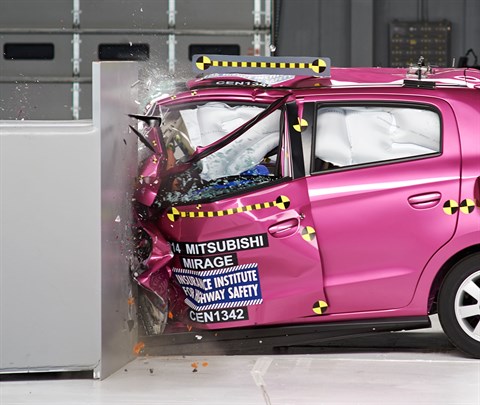
Action shot taken during the Institute's small overlap frontal crash test.

The dummy's position in relation to the door frame, steering wheel, and instrument panel after the crash test indicates that the driver's survival space was not maintained well in the Institute's test.
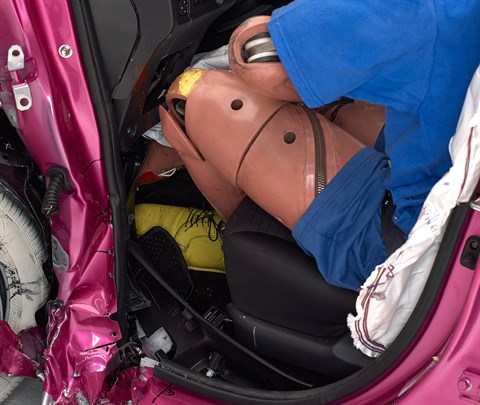
Door hinge pillar and instrument panel intrusion was extensive and contributed to a high risk of injury to the left lower leg and a moderate risk to the left knee (Institute test car shown).
Moderate overlap front: original test
Rating applies to 2014-24 models
Tested vehicle: 2014 Mitsubishi Mirage DE 4-door
The Mitsubishi Mirage hatchback was introduced in the 2014 model year, and the 2016 model year was skipped.
| Evaluation criteria | Rating |
|---|---|
| Overall evaluation | |
| Structure and safety cage | |
| Driver injury measures | |
| Head/neck | |
| Chest | |
| Leg/foot, left | |
| Leg/foot, right | |
| Driver restraints and dummy kinematics | |
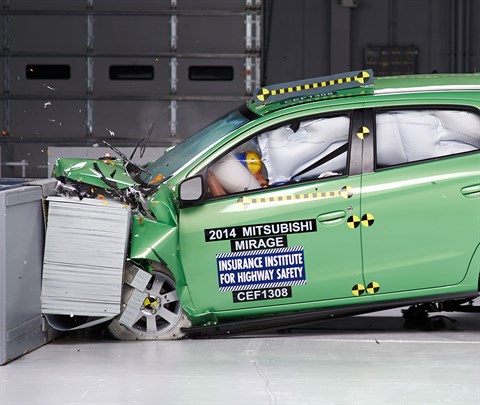
Action shot taken during the moderate overlap frontal crash test.
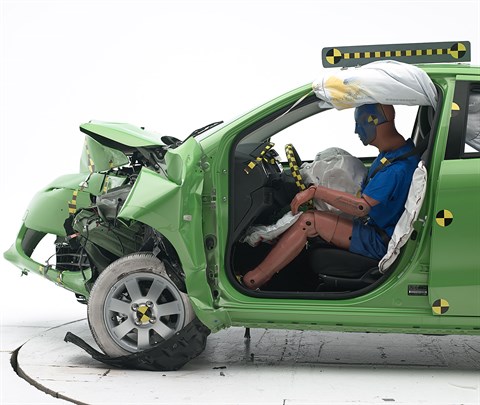
The dummy's position in relation to the steering wheel and instrument panel after the crash test indicates that the driver's survival space was maintained very well.
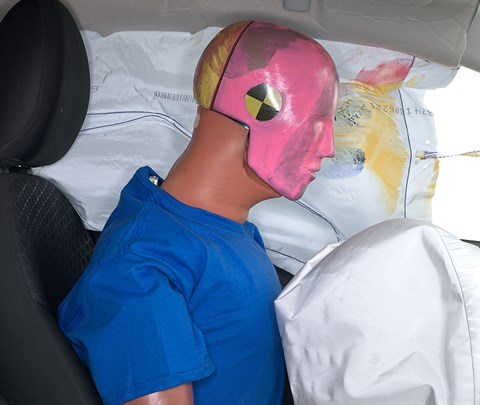
Smeared greasepaint shows where the driver dummy's head was protected from hitting hard structures by the side curtain airbag.
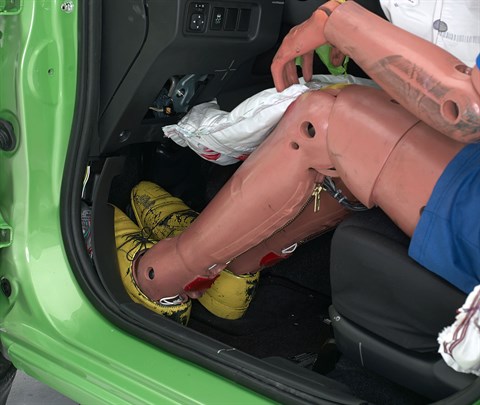
Intrusion into the driver's space was minimal, and all leg and foot injury measures were low.
Side: original test
Rating applies to 2014-24 models
Tested vehicle: 2014 Mitsubishi Mirage DE 4-door with standard front and rear head curtain airbags and standard front seat-mounted torso airbags
The Mitsubishi Mirage hatchback was introduced in the 2014 model year, and the 2016 model year was skipped.
| Evaluation criteria | Rating |
|---|---|
| Overall evaluation | |
| Structure and safety cage | |
| Driver injury measures | |
| Head/neck | |
| Torso | |
| Pelvis/leg | |
| Driver head protection | |
| Rear passenger injury measures | |
| Head/neck | |
| Torso | |
| Pelvis/leg | |
| Rear passenger head protection | |
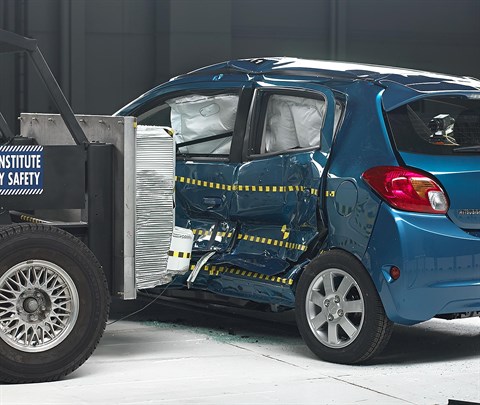
View of the vehicle and barrier just after the crash test.
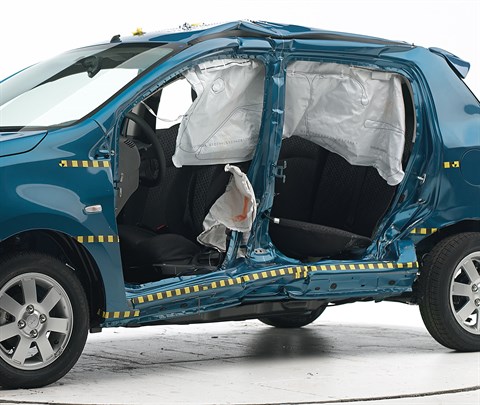
View of the vehicle after the crash with doors removed, showing the side airbags and damage to the occupant compartment.
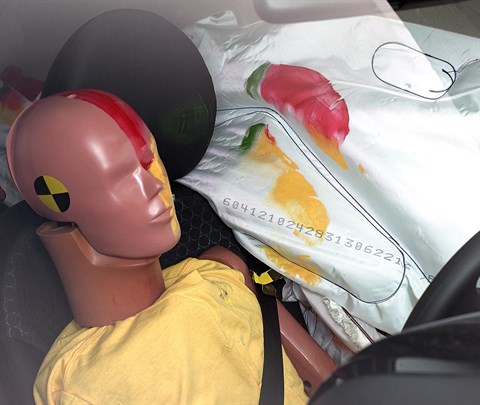
Smeared greasepaint shows where the driver dummy's head was protected from being hit by hard structures by the side curtain airbag.
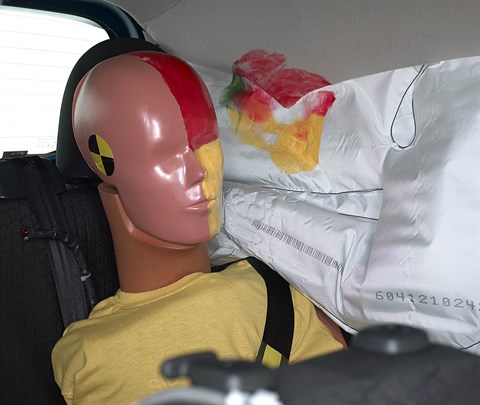
Smeared greasepaint shows where the rear passenger dummy’s head was protected by the side airbag.
Child seat anchors
Rating applies to 2017-24 models
| Evaluation criteria | Rating |
|---|---|
| Overall evaluation | |
| Vehicle trim | SE |
| Seat type | cloth |
This vehicle has 2 rear seating positions with complete child seat attachment (LATCH) hardware.
It has 1 additional seating position with a tether anchor only.
| Evaluation criteria | Rating |
|---|---|
| Overall evaluation | |
| Vehicle trim | SE |
| Seat type | cloth |
| Rating icon | Rating |
|---|---|
| G | Good |
| A | Acceptable |
| M | Marginal |
| P | Poor |
| Seating positions that rely on borrowed lower anchors or have only a tether anchor available are not rated. | |
thether anchor symbol | Tether anchor |
lower anchor symbol | Lower anchors |
| Lower anchor(s) can be borrowed from adjacent positions(s) | |
| No hardware available |
Details by seating position
| Position | Rating |
|---|---|
| 1 | |
| Tether anchor | |
| easy-to-find location | |
| no other hardware could be confused for anchor | |
| Lower anchors | |
| not too deep in seat | |
| not too much force needed to attach | |
| easy to maneuver around anchors | |
| 2 | |
| Tether anchor | |
| easy-to-find location | |
| no other hardware could be confused for anchor | |
| Lower anchors | |
| none available | |
| 3 | |
| Tether anchor | |
| easy-to-find location | |
| no other hardware could be confused for anchor | |
| Lower anchors | |
| not too deep in seat | |
| not too much force needed to attach | |
| easy to maneuver around anchors |
